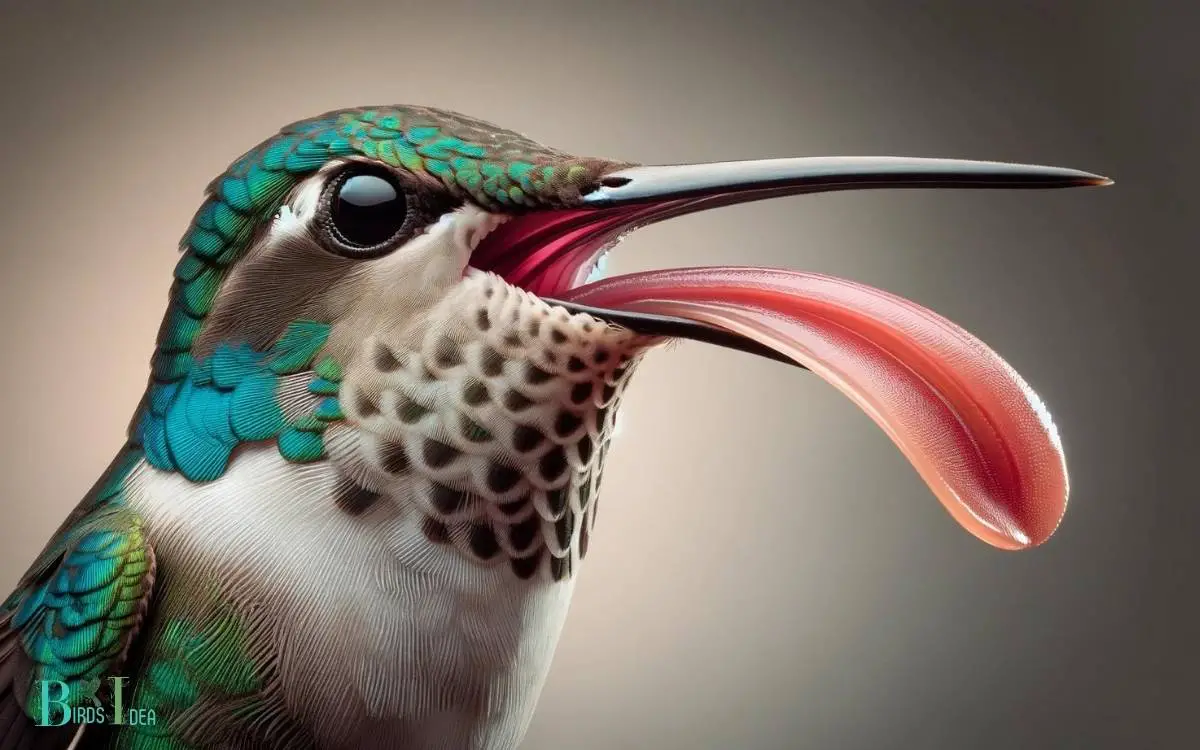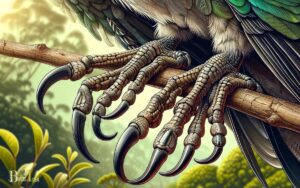How Long Is a Ruby Throated Hummingbird Tongue? 1.4 Inches!
The tongue of a ruby-throated hummingbird can extend up to twice the length of its bill when foraging for nectar. Typically, this means the tongue can reach lengths of approximately 1.5 to 3.5 centimeters (0.6 to 1.4 inches).
Ruby-throated hummingbirds have evolved exceptionally long tongues for their size, which allow them to lap up nectar from deep within flowers.
The tongue is forked and when extended, it acts like a pair of tubes, which open up as the tongue reaches into the nectar and close as it is withdrawn, trapping the nectar inside.
This unique adaptation is key to their survival, as it maximizes their efficiency in feeding from a variety of flowers.
The ruby-throated hummingbird’s elongated tongue is a marvel of nature, perfectly designed for accessing the sweet nectar that fuels their high-energy lifestyle.

Key Takeaway
Ruby-throated Hummingbird Tongue Length and Feeding Adaptation
| Feature | Description |
|---|---|
| Species | Ruby-throated Hummingbird |
| Tongue Length | 1.5 to 3.5 cm (0.6 to 1.4 in) |
| Tongue Extension | Up to twice the bill length |
| Bill Length | Approximately 15 to 18 mm (0.59 to 0.71 in) |
| Feeding Mechanism | Forked, tube-like structure |
| Adaptive Purpose | Efficient nectar extraction from flowers |
Anatomy of a Hummingbird’s Tongue
The anatomy of a hummingbird’s tongue is a fascinating aspect of its unique feeding mechanism. Unlike the tongues of most other birds, a hummingbird’s tongue is long and tubular, extending far beyond the beak.
This adaptation allows them to reach deep into flowers to access nectar, their primary food source. The tongue itself is split at the tip, with the outer edges fringed with hair-like extensions called lamellae.
These structures greatly increase the surface area and capillary action, enabling the efficient uptake of nectar.
The tongue’s flexibility and the ability to extend and retract rapidly enable the hummingbird to exploit a wide variety of flowers, making them highly efficient pollinators.
This specialized tongue anatomy is a key factor in the hummingbird’s remarkable ability to sustain its high-energy lifestyle.
The Incredible Length of a Hummingbird’s Tongue
Extending far beyond the beak, a ruby-throated hummingbird’s tongue is an incredible example of evolutionary adaptation for efficient nectar extraction. The incredible length of a hummingbird’s tongue is a marvel of nature.
Here are four key points to understand its significance:
- Length: A hummingbird’s tongue can extend well beyond its beak, sometimes up to four inches, allowing it to reach the nectar deep within flowers.
- Flexibility: The tongue is highly flexible, allowing it to bend and move with precision, enabling the bird to access nectar in various flower shapes and sizes.
- Capillary Action: The tongue’s structure allows it to take advantage of capillary action, drawing nectar up into the tongue through microscopic grooves.
- Efficiency: This remarkable adaptation enables hummingbirds to efficiently extract nectar, supporting their high-energy lifestyle.
Adaptations for Nectar Feeding
The adaptations that enable the ruby-throated hummingbird to feed on nectar are a marvel of evolution.
From the specialized structure of their tongues, which allow them to efficiently extract nectar from flowers, to their unique feeding behaviors, such as hovering and sipping, these birds have developed remarkable strategies for obtaining their primary food source.
These adaptations have evolved over time, making the ruby-throated hummingbird a fascinating example of the intricate relationship between form and function in the natural world.
Tongue Structure for Nectar
With a specialized tongue that extends up to 3.5 centimeters, the ruby-throated hummingbird has evolved remarkable adaptations for nectar feeding.
The tongue structure for nectar feeding in hummingbirds includes:
- Split-tip Tongue: The hummingbird’s tongue has a tubular shape with a split tip, allowing it to open at the end, enabling the bird to draw nectar up through capillary action.
- Extendable Tongue: The tongue can extend beyond the beak, allowing the bird to reach deep into flowers to access nectar.
- Brush-like Edges: The tongue’s edges have tiny, hair-like structures that aid in collecting and trapping nectar during feeding.
- Fast Withdrawal: The tongue retracts rapidly, allowing the hummingbird to feed at a high frequency and thereby maximizing its nectar intake.
These adaptations make the hummingbird exceptionally efficient at extracting nectar from flowers.
Feeding Behavior Adaptations
Adaptations for nectar feeding in ruby-throated hummingbirds demonstrate remarkable efficiency and precision. Their specialized beak and long, extendable tongue allow them to reach deep into flowers to access nectar.
The bill’s slender and slightly curved shape aids in flower penetration, while the tongue’s bifurcated and fringed edges enable the capture of liquid through capillary action.
Additionally, their unique hovering ability permits them to feed while in flight, enhancing their foraging efficiency.
To maintain their high metabolism, these birds have evolved the capacity to consume up to twice their body weight in nectar each day, requiring them to visit hundreds of flowers.
These adaptations highlight the intricate balance between the hummingbird’s physiology and its nectar-rich diet, enabling its survival and thriving in its ecological niche.
Evolution of Nectar-Feeding Adaptations
Demonstrating remarkable efficiency and precision, the evolution of nectar-feeding adaptations in ruby-throated hummingbirds has been characterized by specialized beaks and long, extendable tongues that enable them to access nectar deep within flowers.
The following factors have contributed to the evolution of nectar-feeding adaptations in these fascinating birds:
- Morphological changes in beak and tongue structure have allowed for more efficient extraction of nectar.
- Enhanced visual acuity and spatial memory have evolved to locate and remember nectar-rich flowers.
- Metabolic adaptations enable efficient energy extraction from nectar, supporting their high metabolic rate.
- Specialized digestive systems have evolved to process the high sugar content of nectar.
These adaptations have collectively allowed ruby-throated hummingbirds to thrive as nectar-feeders, demonstrating the intricacies of evolutionary processes in shaping their unique feeding behaviors.
This evolution of nectar-feeding adaptations has also influenced the development of their tongue extension mechanism.
Tongue Extension Mechanism
The ruby-throated hummingbird’s tongue extension mechanism allows for efficient nectar extraction and is a remarkable example of specialized adaptation.
When a hummingbird inserts its tongue into a flower, it can extend its tongue beyond the bill, thanks to its unique tongue structure.
The tongue has a bifurcated or forked tip which allows it to open and close rapidly, trapping nectar through capillary action.
As the tongue retracts, the nectar is pulled into the mouth. This mechanism enables the hummingbird to rapidly feed on nectar, with some species capable of performing up to 13 licks per second.
The rapid and precise extension of the tongue allows the hummingbird to access nectar from deep within flowers, providing a competitive advantage in the search for food.
Unique Structure and Functionality
How does the unique structure of the ruby-throated hummingbird’s tongue contribute to its remarkable functionality in nectar extraction?
The remarkable functionality of the ruby-throated hummingbird’s tongue is attributed to its distinctive structure, which enables efficient nectar extraction.
The following points shed light on the unique structure and functionality of this fascinating organ:
- Split-tip shape: The forked tongue tip allows the hummingbird to maximize nectar intake by capturing liquid through capillary action.
- Extendable and flexible: The tongue can extend beyond the bird’s beak, enabling access to nectar deep within flowers.
- Elastic microstructures: Tiny hair-like extensions called lamellae increase the surface area, enhancing the tongue’s ability to collect nectar.
- Fast retraction: The tongue can retract at remarkable speed, allowing the bird to feed rapidly and efficiently.
Feeding Behavior and Efficiency
What role does the unique structure of the ruby-throated hummingbird’s tongue play in its feeding behavior and efficiency?
The hummingbird’s specialized tongue allows it to efficiently extract nectar from flowers. The tongue is long and extends beyond the bill, allowing the bird to reach deep into flowers to access nectar.
The tip of the tongue is fringed with tiny, hair-like structures called lamellae, which aid in trapping and drawing up the nectar through capillary action.
This unique adaptation enhances the bird’s feeding efficiency, enabling it to consume nectar more effectively.
The following table summarizes the key features of the ruby-throated hummingbird’s feeding behavior and efficiency:
| Feeding Behavior and Efficiency | Description |
|---|---|
| Long tongue | Allows access to deep flower nectar |
| Fringed with lamellae | Aids in trapping and drawing up nectar |
| Enhanced feeding efficiency | Enables effective consumption of nectar |
This efficient feeding behavior is crucial for sustaining the high metabolic rate of these remarkable birds.
Evolutionary Advantages of a Long Tongue
Evidently, the evolutionary advantage of the ruby-throated hummingbird’s long tongue lies in its ability to consistently access nectar from deep within flowers, facilitating efficient foraging.
This adaptation confers several benefits:
- Access to Deeper Nectar: The long tongue allows the hummingbird to reach the nectar in flowers with long corollas, providing access to untapped energy resources.
- Reduced Competition: By exploiting deeper nectar sources, the hummingbird can minimize competition with other nectar feeders that may not have the requisite tongue length.
- Energy Efficiency: The ability to extract more nectar with each visit reduces the energy expenditure associated with frequent foraging.
- Pollination: As the hummingbird probes deep into flowers, it inadvertently promotes cross-pollination, benefiting both the plant and the bird.
This evolutionary trait thus enhances the bird’s foraging effectiveness and contributes to its ecological role as a pollinator.
Conservation Implications for Hummingbirds
With regard to conservation, the preservation of suitable habitats is crucial for sustaining hummingbird populations and their vital role as pollinators.
Hummingbirds rely on diverse ecosystems with an abundance of nectar-producing flowers, making habitat conservation essential for their survival.
Additionally, the protection of migratory routes is vital as many hummingbird species undertake long-distance migrations, facing threats such as habitat loss and climate change along their journey.
Here is a table summarizing key conservation implications for hummingbirds:
| Conservation Implications | Description |
|---|---|
| Habitat Preservation | Crucial for sustaining hummingbird populations |
| Protection of Migratory Routes | Vital for safeguarding hummingbirds during migrations |
| Biodiversity Conservation | Essential for providing diverse nectar sources |
| Mitigating Climate Change | Important for addressing threats to hummingbird habitats |
Conclusion
The remarkable length of the ruby-throated hummingbird’s tongue serves as a symbol of the amazing adaptability and efficiency of this tiny bird.
The unique structure and functionality of its tongue allow the hummingbird to access nectar from deep within flowers, showcasing the beauty of nature’s design.
Understanding the evolutionary advantages of the long tongue and its role in feeding behavior has important conservation implications for the preservation of hummingbird populations.






